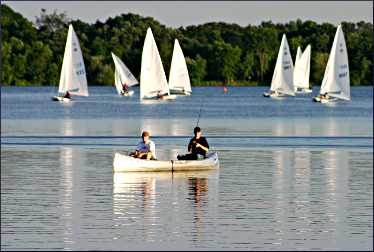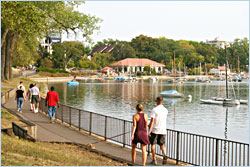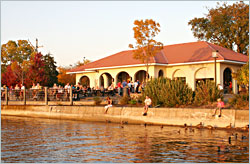Chain of Lakes in Minneapolis
The lakes, river and creeks that ring this metropolis are a magnet year-round.

© Beth Gauper
Every big city has skyscrapers. Every big city has museums and monuments. But no other city has as many beautiful lakes and parks as Minneapolis does.
Early in the city's history, when its lakes still were considered swampy boondocks, city fathers decided to make their shores public property.
Today, the most expensive homes in the city face the lakes, but the public — in-line skaters, bicyclists, dog-walkers — owns the shorelines.
In the summer, everyone who isn't working flocks to the lakes to canoe, sail, skate, swim and picnic. Concerts are held nearly every evening at the lovely Lake Harriet bandshell, and neighborhood festivals and theater performances are held in lakeside parks.
Paved paths — one for walking, one for bicycling and skating — link the lakes, looping around the four biggest lakes and extending across the city and up along both sides of the Mississippi River.
They're hugely popular with runners and walkers, who can be found on them all year-round.
These paths now are part of the Grand Rounds National Scenic Byway, which includes 50 miles of trails.
To make shorter loops, bicyclists can use the Midtown Greenway, which cuts straight across south Minneapolis. For more, see Biking in Minneapolis.
The most scenic stretches are in the southern part of the city, between Lake of the Isles and Bde Maka Ska, Harriet and Nokomis lakes to Minnehaha Park and up the Mississippi River to the east end of Franklin Avenue.
This route also is the first 19 miles of the Twin Cities Marathon, held the first Sunday in October and often called the most beautiful urban marathon in America.
Bde Maka Ska (pronounced beh-DAY mah-KAH skah) is the former Lake Calhoun. The Dakota name means White Earth Lake, referring to the light sand of the beaches. The old name honored South Carolina slaveowner and slavery advocate John C. Calhoun, who as secretary of war also planned the Indian Removal Act of 1830.

© Torsten Muller
Lake of the Isles can be found at the west end of Franklin Avenue. The most baronial houses are found here, along with the most geese and other wildlife; there are no beaches, but two islands serve as wildlife refuges, and there's an ice rink in winter.
Canoeists can put in on Lake of the Isles and navigate a shady little canal to Cedar Lake, which has beaches on three sides.
On the east side, East Cedar Lake/Hidden Beach is three blocks from the big Victorian known as the Mary Tyler Moore house, on the southwest corner of Kenwood Parkway and West 21st Street.
Lake Street passes between Lake of the Isles and Bde Maka Ska and heralds the Uptown neighborhood, just to the east. Bikes can be rented here, and every kind of snack found — smoothies, ice cream, cappuccino.
It's also a shopping and restaurant center, especially for young people, and it's one of the liveliest neighborhoods in the city both day and night.
Bde Maka Ska has three beaches and the most open expanses; it's often used for windsurfing and sailing. It connects to Lake Harriet, the prettiest and most family-oriented lake; a vintage streetcar also connects the two lakes.
Around Lake Harriet, the Rose Garden is a favorite spot, as well as the two beaches, the bandshell and playground just beyond it.
For a pleasant detour, venture two blocks from the western side of Lake Harriet to the little shops and cafes of the Linden Hills neighborhood, at the corner of Upton Avenue and West 43rd Street.
Then continue around Lake Harriet to Minnehaha Creek, which the path follows to Lake Nokomis. This lake has a big, broad beach, with an up-close view of planes going to and from the airport. Hiawatha Lake, up and across the parkway, has a smaller beach.
From there, it's not far to Minnehaha Park, whose thundering falls have been a tourist attraction since the city's birth. Footpaths wind through the gorge at the foot of the falls, following the creek to its meeting with the Mississippi.

© Beth Gauper
The path continues along the river, as it flows upstream to the falls of St. Anthony. The campus of the University of Minnesota straddles the river north of the Franklin Bridge; the Weisman Art Museum, a fractured silver pile on the east side of the river, is worth a stop.
From there, it's not far to James J. Hill's Stone Arch Bridge, where the city started.
For more about the Stone Arch Bridge and St. Anthony Main area, see On the river in Minneapolis.
Trip Tips: Chain of Lakes in Minneapolis
Touring: On weekends, the paths can get crowded. Bicycle paths are one-way, which cuts down on congestion.
For more about bicycling in and from the city, see Biking in Minneapolis.
Bike rental: In Minnehaha Park, Wheel Fun rents bicycles and surreys.
Nice Ride Minnesota has bike-sharing at many stations throughout Minneapolis including Uptown, near Lake of the Isles and Bde Maka Ska.

© Beth Gauper
Paddling: The paddle from Bde Maka Ska to Lake of the Isles, Cedar Lake and Brownie Lake is very popular.
Wheel Fun rents canoes, kayaks and paddleboats at Bde Maka Ska, Lake Harriet and Lake Nokomis.
Beaches: The Grand Rounds connects the beaches on Nokomis, Harriet, Maka Ska and Cedar lakes. The larger main Nokomis beach has a floating swimming dock, large fee parking area and basic concessions; there's a smaller beach on the other side of the lake that has no lifeguard or bathhouse.
Lake Harriet has two small family beaches, one not far from the bandshell, playground and concessions at Bread & Pickle. There's a fee parking lot that often fills.
Bde Maka Ska is more open and attracts singles from the Uptown area. On the south end of the lake, Thomas Beach has a floating swimming dock and sand-volleyball courts. There's a small fee-parking lot.
On the north end, there's a canoe and kayak rental and concession, flanked by North Beach and 32nd Beach. It's hard to find parking.
Cedar is the quietest lake. East Cedar Beach, reached through the Kenwood neighborhood, has been known as Hidden Beach; it's not too hard to find parking on nearby streets. Cedar Point and Cedar South beaches have a few free parking spots.
Lifeguard schedules vary.
There's also a beach on Lake Hiawatha, near Lake Nokomis, and Wirth Lake, north of Cedar Lake on the Grand Rounds.
Free concerts: Free concerts are given nearly every summer evening at the Lake Harriet bandshell, usually at 7:30 p.m. and on Sundays at 2 and 5:30 p.m.
In Minnehaha Park, free concerts are at 7 p.m. Wednesdays through Fridays, and there's a bluegrass festival on Labor Day.

© Beth Gauper
Trolley ride: The Como-Harriet Streetcar takes 15-minute runs from Lake Harriet, near the bandshell at Queen Avenue and West 42nd Street, to Bde Maka Ska.
It runs weekends from May to October and Wednesdays-Fridays from June to September. Check for exact times. There are also special theme and holiday rides.
Round-trip fare is $3, and an all-day pass is $7.
Annual events: City of Lakes Loppet, first weekend in February. Uptown Art Fair, first full weekend in August. Twin Cities Marathon, first Sunday in October.
Dining: In the 1905 refectory in Minnehaha Park, Sea Salt Eatery serves inexpensive seafood, such as soft-shelled crab sandwiches and oyster po' boys. It's open daily for lunch and dinner, 612-721-8990.
On the beach on the north end of Lake Nokomis, Painted Turtle serves casual global fare. (Watch for it; the main bike trail passes a block away.)
Next to the Lake Harriet bandshell, Bread & Pickle serves scones, muffins and egg sandwiches for breakfast and sandwiches and burgers for lunch and dinner, plus espresso drinks and ice cream. The food is locally sourced, and all containers can be composted.
The restaurant in the refectory on Bde Maka Ska burned down in 2019, and a new one is expected to open for summer 2023.
Information: Minneapolis Parks and Recreation.